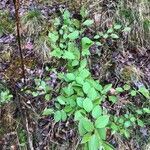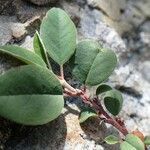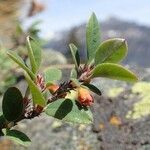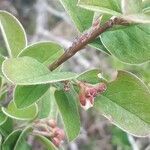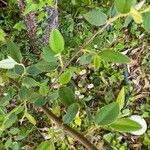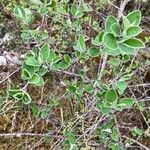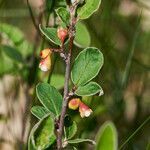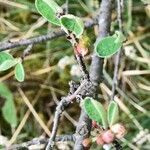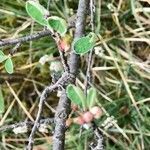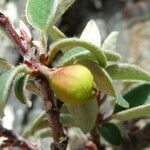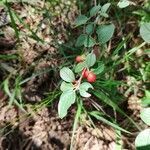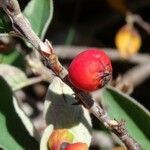Shrubs deciduous, erect, to 2 m tall, much branched, with broad spreading crown. Branchlets brown or grayish brown, terete, initially densely gray tomentose, soon glabrescent. Petiole 2–5 mm, tomentose; stipules mostly persistent at fruiting, lanceolate, puberulous; leaf blade broadly elliptic, broadly ovate, or suborbicular, 2–5 × (0.5–)1.3–2.5(–3) cm, veins raised abaxially and impressed adaxially, abaxially densely gray tomentose, adaxially glabrous or sparsely pubescent, base rounded, apex acute or obtuse, usually mucronate. Corymbs or 1.5–2.5 cm, 2–5(–7)-flowered; rachis and pedicels glabrous or puberulous; bracts lanceolate, puberulous. Pedicel 3–6 mm. Flowers ca. 8 mm in diam. Hypanthium campanulate, glabrous or puberulous abaxially. Sepals triangular-ovate, 1–1.5 × 1–2 mm, apex obtuse. Petals erect, pink, suborbicular, ca. 3 mm in diam., base clawed, apex obtuse. Stamens 15–20, nearly as long as petals. Ovary pilose apically; styles 2, rarely 3, free, not exceeding stamens. Fruit red or dark red, subglobose, rarely ovoid, 6–7(–8) mm in diam., glabrous, pyrenes usually 2, rarely 3 or 4. Fl. May–Jun, fr. Aug–Sep. 2n = 68.
More
A shrub that loses its leaves. It grows 2 m high and spreads 2 m wide. The stem is twisted. The branches are low and spreading. The leaves are round or oval and have short leaf stalks. They are green. The flowers are small and pink. They hang in clusters of 2 or 3. The fruit are small, round red berries.
It is a temperate plant. It is best in well-drained gravelly soil. It needs an open sunny position. It is resistant to frost and drought. In northern China it grows on rocky slopes below 2,500 m above sea level.
